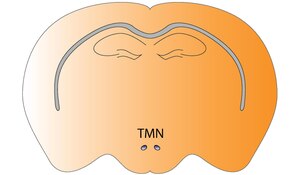| Tuberomammillary nucleus | |
|---|---|
 Tuberomammillary nucleus of the mouse brain | |
| Details | |
| Part of | Hypothalamus |
| Identifiers | |
| Latin | nucleus tuberomamillaris |
| Acronym(s) | TMN |
| NeuroNames | 427 |
| NeuroLex ID | birnlex_1271 |
| TA98 | A14.1.08.932 |
| TA2 | 5734 |
| FMA | 62335 |
| Anatomical terms of neuroanatomy | |
The tuberomammillary nucleus (TMN) is a histaminergic nucleus located within the posterior third of the hypothalamus. [1] It is part of the tuber cinereum. [2] It largely consists of histaminergic neurons (i.e. histamine-releasing neurons). It is involved with the control of arousal, learning, memory, sleep and energy balance. [1]